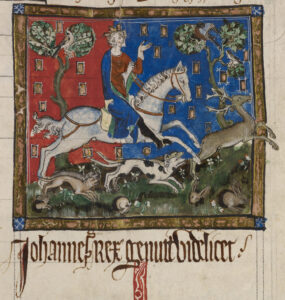
King John’s Castle, also known as Carlingford Castle, played a role in 500 years of Irish history from medieval times to the Battle of the Boyne.
Carlingford Castle is located in a strategic position on a high rocky outcrop point above Carlingford’s harbor on the south side of Carlingford Lough.
The original section of the castle, its west wing, was built in the late 12th century by Hugh de De Lacy, Lord of Meath, shortly after the Norman invasion of Ireland. De Lacy was a wealthy and powerful Anglo-Norman landowner and royal office-holder.

King John hunting a stag with hounds.
De Lacy accompanied King Henry II as part of an Anglo-Norman invasion of Ireland in October 1171.
In early 1172 De Lacy was sent accept the surrender of Rory, the last High King of Ireland prior to the Anglo-Norman invasion. Before King Henry returned to England around the end of March 1172, De Lacy was granted authority over Meath and was given command of Dublin Castle.
The catch for De Lacy was he had to gain control of the portions of Ireland that Henry had granted to him. In an effort to control eastern Ireland, De Lacy began building a series of castles, including Trim Castle in Meath, Kilkea Castle, and a mott-and-baily structure in Clandard in County Meath.
Returning to England in late 1172, De Lacy was involved in a dispute with Archbishop of Canterbury Richard of Dover and in 1173 he led in an unsuccessful battle in France during fighting with French King Louis VII.[1]
De Lacy returned to Ireland as procurator-general in 1177 and quickly became a controversial figure.
As governor of Ireland De Lacy took control of both Leinster and Meath and continued building numerous castles.
De Lacy’s marriage to an Irish princess angered Henry.
De Lacy married the daughter of Ruadri O Conchobair, deposed High King of Ireland, in 1181 without asking Henry’s permission. He was recalled from his royal post because of the marriage. But he was sent back Ireland in 1182, this time with royal clerk Robert of Shrewsbury watching over him.
Henry sent his son John, the future King John, to Ireland in 1185. The prince complained to his father that De Lacy was preventing the Irish from paying tribute.
King John supposedly stayed in the castle for three days in 1210 while his army crushed a rebellion by Ireland’s Anglo-Norman lords. It then became known as King John’s castle.
Some accounts accuse De Lacy of trying rule Ireland on his own.
One account says De Lacy lost favor because of complaints of his injustice by the Irish. His mistreatment of the Irish leadership may have led to his death in 1186.
De Lacy’s murder is described in the Annals of Ulster –
“A.D. 1186. Hugo de Lacy went to Durrow to make a castle there, having a countless number of English with him; for he was king of Meath, Breifny, and Oriel, and it was to him the tribute of Connaught was paid, and he it was that won all Ireland for the English. Meath from the Shannon to the sea was full of his castles and English followers. After the completion of this work by him, i.e., the erection of the castle of Durrow, he came out to look at the castle, having three Englishmen along with him. There came then one youth of the men of Meath up to him, having his battle-axe concealed, namely Gilla-gan-inathar O’Megey, the foster son of the Fox himself (chief of Teffia), and he gave him one blow, so that he cut off his head, and he fell, both head and body, into the ditch of the castle.”
O’Megey, escaped. His motive may have been revenge for seizures of land by De Lacy, according to Alfred Webb’s A Compendium of Irish Biography, published in 1878.
In 1326 control of the castle was given to Geoffrey le Blound, then to Edmond Loundres in 1388, and Stephen Gernon in 1400. Henry MacShane O’Neill attempted to capture the castle in 1596.
The castle was held by the Irish Catholic Confederation during the Irish Confederate Wars 1641 to 1653. Sir Henry Tichborne, (Parliamentarian) gained control of the castle in 1642, then by Murrough O’Brien in 1649 and Charles Coote in 1650.
Jacobites fired on the castle in 1689 during the Williamite War. It was used as a Williamite hospital prior to the Battle of the Boyne.[2][3]
[1] Kingsford, Charles Lethbridge (1892). “Lacy, Hugh de (d.1186)”. In Lee, Sidney (ed.). Dictionary of National Biography. Vol. 31. London: Smith, Elder & Co.
[2] “Castles.nl – Carlingford Castle”, https://www.castles.nl/carlingford-castle.
[3] “Castle works progress – Independent.ie”, https://www.independent.ie/regionals/argus/news/castle-works-progress-31177882.html.
Four Masters, Annals of Ireland by the: Translated and Edited by John O’Donovan. 7 vols. Dublin, 1856.
Giraldus Cambrensis: Topography, and History of the Conquest in Ireland: Forester and Wright. London, 1863.
Music: Far Over The Highlands, Christopher Moe Ditievsen; The Norman Kings, Bonnie Grace
#ireland #irish #IrishHistory #irishcastle #history #carlingford #CountyLouth #englishhistory
